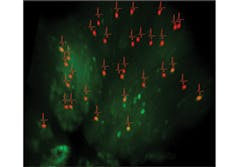Multiphoton holography and new opsins allow 3D tens-of-neurons stimulation
In late 2017, Laser Focus World described how a University of California, Berkeley three-dimensional scanless holographic optogenetics with temporal focusing (3D-SHOT) technique enabled optogenetic photostimulation of custom neuron ensembles by combining computer-generated holographic (CGH) illumination with temporal focusing. Now, the UC Berkeley scientists have combined their technology with multiphoton imaging, enabling read and write operations with individual neurons precisely in time and space. For this, they developed new opsins that work in conjunction with 3D-SHOT.
To spike neuronal activity, the team developed ChroME (which exhibits 3–5X larger photocurrents than comparable multiphoton opsins) to achieve cellular resolution at millisecond precision. To suppress neuronal activity, the team improved the GtACR1 inhibitory opsin (80X photocurrents) by preventing cellular toxicity with a new construct. Using the new opsins and 3D-SHOT, up to 50 neurons can be stimulated in a 550 × 550 × 100 µm3 section of brain tissue. Compared to the late 2017 research, this new implementation now provides neuroscientists with a practical all-optical solution to monitor and manipulate neural activity in real time, and will enable many new experiments aiming to understand how the brain operates. Reference: A. R. Mardinly et al., Nat. Neurosci., 21, 881–893 (2018).
About the Author

Gail Overton
Senior Editor (2004-2020)
Gail has more than 30 years of engineering, marketing, product management, and editorial experience in the photonics and optical communications industry. Before joining the staff at Laser Focus World in 2004, she held many product management and product marketing roles in the fiber-optics industry, most notably at Hughes (El Segundo, CA), GTE Labs (Waltham, MA), Corning (Corning, NY), Photon Kinetics (Beaverton, OR), and Newport Corporation (Irvine, CA). During her marketing career, Gail published articles in WDM Solutions and Sensors magazine and traveled internationally to conduct product and sales training. Gail received her BS degree in physics, with an emphasis in optics, from San Diego State University in San Diego, CA in May 1986.
